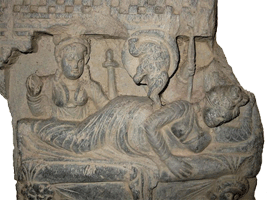There are many wonderful stories about how the Buddha’s birth was accompanied by celebrations by the gods, about how he came into the world in an unusual way, [1] and his first steps and his first words. Like all the founders of major religions, stories and myths grew and multiplied. But, like all mythic heroes, the historical facts are far less available. Karen Armstrong’s book Buddha is a concise presentation of what we really know of the historical Buddha. The proven historical facts are few and can be summarized quickly.
Siddhatta Gotama of the Shakya tribe was born in Kapilavatthu in the small country of Shakka. [2] Shakka was in a very remote area of what is now the western edge of Nepal. Shakka was squeezed between the larger kingdoms of Magadha to the southeast, located in modern Bihar, India, and Kosala directly west. It was a time of political strife and physical danger.

The generally accepted year of birth for the Buddha is 563 B.C.E., although some Chinese scholars put this one hundred years later. The Buddha lived for eighty years. Siddhatta was a prince, his father one of the many aristocrats who participated in governing Shakka. When he was twenty-nine, Gotama left his family, including his newborn son, to search for the answer to why life was so filled with suffering, and to find a way to end suffering.
The future Buddha first studied yoga under two masters; he became an adept at all the yogas his teachers taught. This included mastery of the deepest meditations and the highest levels of samadhi. Gotama became a very accomplished yogin, but he found that the real answers he was seeking still eluded him. The highest knowings offered by his teachers were not the ultimate realization. He left each teacher and, living with five other devoted yogins, practiced on his own. His yoga was fierce; he almost died from his austerities.
Six years after his renunciation of the privileged life in Shakka, Siddhatta renounced this new life as well. Extremism, he declared, was not the answer. From now on he would practice only the middle way, a path of moderation. He decided, as Armstrong writes, “to work with human nature and not fight against it.” This meant he would steer a path between giving into the pleasures of the world self-indulgently, and the extreme, body-denying asceticism of the yogis and Jains.
Sitting down under a tree, Siddhatta vowed not to move until he achieved enlightenment. He succeeded and then, after a time of internal debate over what he should do next, he decided to share what he had learned with the world. For the next forty-five years, the now awakened one, the Buddha, taught. Although he taught, he knew that ultimate realization cannot be taught; the way can only be pointed to. The individual must walk the path personally. All a Buddha could do was point the way to the path.
The Buddha left the world in 483 B.C.E., after suffering a fatal and painful case of dysentery, an unfortunately common disease of the time.
This much is known about the Buddha. Also known is where he taught, whom he taught, and the way the teachings were passed down through the generations. But, beyond these dry facts, there arose many wonderful stories and metaphors, each with its own value to the student of the mind. Joseph Campbell warns us that whenever we read mythic stories, we must not read them as if they were facts. To believe these myths are historical truths would be to reduce them to the equivalent of dry headlines in a newspaper. The proper way to digest these stories is to ask what they mean to you! Personally! What does the fact that the awakened one is said to have sprung from his mother’s side at the level of the heart, and not in the normal way, mean for you? [3]
What motivated the Buddha to seek enlightenment was his observation of the conditions of life. He saw sickness, he saw aging, he saw death. In the midst of all this suffering, he saw a holy man attempting to free himself from the afflictions of life. Siddhatta decided to personally seek the solution to suffering. Upon his enlightenment he realized he had indeed found the way. He called the way the Four Noble Truths.
- — He exited from his mother’s side at the level of the heart.
- — We are using the Pali version of these words. Often we may see the Buddha’s name written in the Sanskrit language as Siddhartha Gautama.
- — A wonderful and enjoyable side trip is to visit these mythical stories about the Buddha. Many of Joseph Campbell’s books have several illuminating tales. You may want to read the Transformation of Myth through Time for several illustrative stories. A more extended side trip would lead you to the works of Campbell’s good friend Heinrich Zimmer and his weighty book Philosophies of India. Right now our journey takes us deeper into the main teachings of the Buddha.
(Next: The Four Noble Truths )
